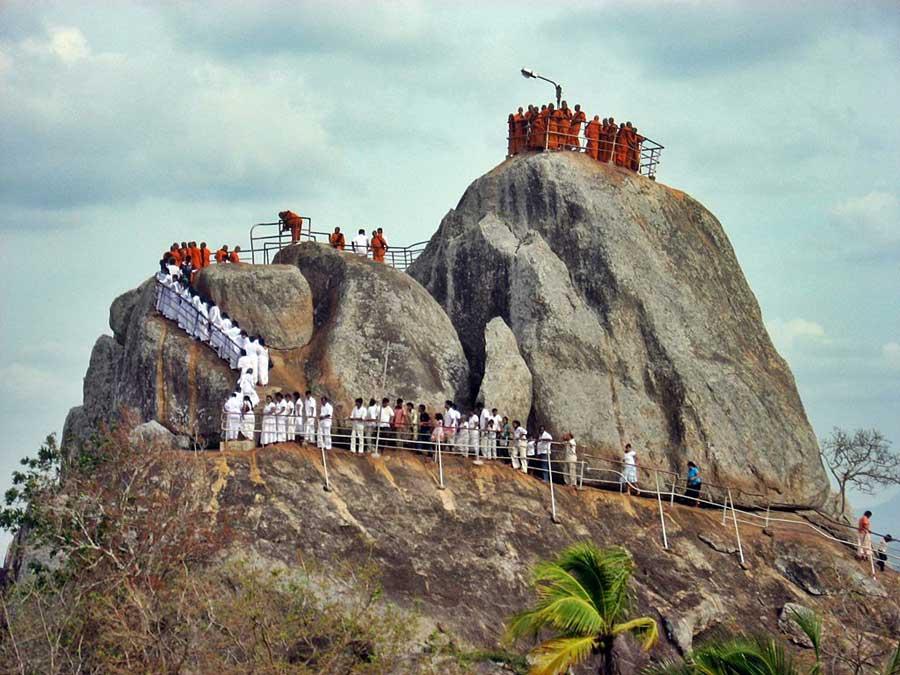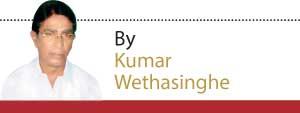Reply To:
Name - Reply Comment

The Maha Seya, 41 metres high and 44 metres in diameter, as seen from below.
- Poson Poya Day is a victory day for Sri Lanka
- The Path of Sublime Truth, is the priceless sacred treasure bestowed on us by the Emperor Dharmasoka
- Asoka not only embraced Buddhism, but also declared it as the State Religion of Jambudeepa (country of red apple)
When the full moon shines over the ‘pearl of Indian Ocean’, Srilankans celebrate the annual Poson Festival in the month of June. Srilankans observe Poson Poya Day, as the dawn of national renaissance.
Sakyamuni Tathagata Gautama, declared “Bhikkus, what middle path comprehend by Tathagata produces vision, knowledge and leads calm, penetration, Enlightenment Nibbhana”.
“In realising the four Noble Truths and eightfold noble path there arose in me vision, knowledge, insight, wisdom, light (Aloko Udapadi), things unknown hither to anyone”.
Poson Poya Day is a victory day for Sri Lanka. In as much as the Vesak Day signify the triple significance the Birth, Enlightenment and the Reclining of the Tathagata. The Poson Day, reminiscences the advent of Maha Samana Arahant Mahendra, to establish the sublime path, which transformed Sri Lanka to a Dharmadeepa.
The Path of Sublime Truth, is the priceless sacred treasure bestowed on us by the Emperor Dharmasoka.
Maurian king Asoka, who ascended the throne in 269 B.C. was married to Queen Vasudevi of Vadisapura. They were blessed with a son and a daughter namely, Prince Mahendra and Princes Sanghamitta.
Being a tyrant worrier Emperor Asoka, conquered the entire network of neighbouring states an almost 1/3 of the planet. Then, he was identified as “Chandasoka”. However, his battle against Kalinga, became a turning point in his life. Asoka was shocked and anguished at the brutal carnage of the war.
Remorse stricken Emperor at his balcony noticed a Novice bhikkhu, peacefully and gracefully moving down the street. Through a messenger he invited the monk to the palace. During the brief dialog he had with the samanera, the emperor was consoled. He also realised the sinful consequences of war and vowed to shun violence.
Asoka not only embraced Buddhism, but also declared it as the State Religion of Jambudeepa (country of red apple).
Under the guidance of Arahant Moggaliputta Maha Thera, the 3rd Sanghayana (235 B.C.), was held under Royal patronage at Patali Nagar. Inoder to cleanse, protect and propagate the Buddha Sasana.
Thence, it was resolved to deploy Arahant bhikkhus as missionaries to nine foreign countries including Greece, Miyanmar and Sri Lanka.
Asoka enjoyed moral victory than territorial victory and implementing to Buddha’s advice given to Bhikkhus to spread the truth, “Carika Bhikkhave Carikam – Bahu Janna Hitaya – Bahu Jana Sukaya”
“For the Happiness of many and for the welfare of many go from place to place and enlighten”.
Asoka launched his missionary service inland and overland intensively.
Subsequently, he became Dharmasoka. As his final gesture the Emperor consented to ordain his only son and daughter, Crown Prince Mahendra and princes Sanghamitta to Bhikkuhood.
In the past (247 B.C.), though the economy remained stable with foreign diplomatic connections, the Srilankan social standards were at a low ebb, in spiritual aspects. They worshipped the sun, moon, trees, rocks and even dead souls seeking protection and benefits.
Following the demise of King Mutasiva, Devanampiya Tissa ascended the throne (250 – 210 B.C.). Though they never met each other, Emperor Asoka and King Devanampiya Tissa had a cordial friendship.
Asoka, was delighted and replied that he had embraced Buddhism and adopted a non violent policy. He urged his Sri Lankan counterpart too, to do the same and promised to send a religious missionary.
According to the prevailed traditions the King of Sri Lanka too, involved himself with his army on a hunting expeditions. It was a Poson full moon day, Arahant Maha Mahendra, had already set foot on the Ambastala rock, accompanied by four Arahant Bhikkhus.
Being a day of destiny as the King was targeting an arrow at a running deer, a Clarian command came from above “Tissa! Tissa! Stop!”. Hearing him addressed by his name, the King was shocked and looked up to find the strange group at the summit of Mihintale.
Commencing with a self introduction the Arahant announced,
“Samana mayam maharajha - Dhammarajassa savaka
Themeva anukampaya - Jambudeepa idagatha”
“Oh great King - Samanas are we,
The disciple of the king of truth - with compassion towards thee
Are we coming from Jambudeepa” (Country of red apple) ?
On hearing the magnificent verse the King’s fear left and became consoled. At the same time he recollected the recent message from Emperor Dharmasoka. Soon he approached the Maha Samana Mahendra, to pay his reverence and exchange greetings.
Since Buddhism is not meant for the unwise, the Mahasamana, adopted a psychological approach towards the King to open the dialogue in the form of talent quest.
According to chronicle Mahavansa, the Arahant firstly quarried of their natural environment from the King.
Q Maharaja what kind of tree is this?
Venerable this is a mango tree.
Q Besides this mango tree do you find anymore mango trees?
Yes Venerable there are plenty of mango trees.
Q Besides this mango tree and other mango trees do you find any other trees?
Of course venerable there are variety of other trees.
Q Has thou, Kings folk O’King?
There are many.
Q Are there also others who are not Kinsfolk?
Yes Venerable others are in majority than my Kinsmen.
Q Is there anyone besides Kinsfolk and others?
There is myself / the King.
Being pleased with the Kings intelligence the Maha Samana, preached “Chulla Hattipadopama Sutta” (Buddhadahamma in condensed form), to the King and his retinue. The Sutta is based on a tale of elephants very much familiar to Sri Lanka.
“Start, set forth, observe the path of Enlightenment! Destroy the armies of Mara (Evil one), as an elephant crushing a Bamboo Hut. This path leads to eradicate defilements bringing an end to the sorrowful cycle of births. At the end of the discourse the King and his men embraced Buddhism. The day after Poson, Arahant was received by the members of the Royal family, at the Kings Palace. On that occasion the Arahant delivered sermons on ‘Vimana Vattu’ & ‘Peta Vattu’. These two discourses explain the suffering of spirits and of heavenly beings and were appropriately relevant to the existing religious beliefs of the local society at the time. On the 27th day following the arrival of the missionary, a member of the Royal family namely Prince Aritta and a group of 50 others became the first fortunate batch to enter the order of Bhikkhus in Sri Lanka. Nearly 60 rock cells which they occupied and the Mihindu cell, can still be seen at Mihintale.
It is recorded that at the end of the first discourse, Sumana Samanera had attained Arahantship while 40,000 devotees had attained “Sovan” status.
There was anxiety and religious thirst among the female sectors too. Headed by Queen Anoma, they made an appeal to the King expressing their desire to enter the Bhikkhuni order. When the King placed the issue before Arahant Mahendra, it was resolved to send a Royal delegation to Jambudeepa, seeking Emperor’s patronage.
Ushering another golden chapter in the Sasana history, Arahant Sanghamitta Maha Theri arrived at the City of Anuradhapura. Moreover, she brought with her the Right wing Bo – sapling of the Jayasiri Maha Bodhi of Buddhagaya. The sacred bodhi replanted at the Mahameuna gardens Anuradhapura, flourishes up to date and is also glorified and venerated as the worlds oldest tree. Ambastala rock also known as the Aradanagala, Chethiy pabbhata, or Missaka Pawwa (Rock of Invitation) is the “Cradle of Buddhism”.It is ironically one of the most sacred worshipping centers of our nation, being the golden spot where Arahant Maha Mahendra and the holy group descended on Poson Full moon Day, by means of divine psychic powers.
Today the great Stupa or the ‘Mahaseya stands’ there, enshrined with Buddha relics. Beside is the “Mihindu Seya” built enshrine the relics of Maha Samana Mahendra.
Mihintale is a unique spiritual and archaeological assert with historical rock caves occupied by the Arahant Bhikkhus.
During the past 2328 years thousands of pilgrims climb up 1840 rock stairs to its summit. This is perhaps the Worlds grandest rock stairway.
Historically the Sinhala race originated with the landing of Prince Wijeya at Tambapani in 483 B.C. coincidentally when Alexander the Great, was invading Western Asia.
The advent of Arahant Maha Mahendra, gave rise to resplendency in moral civilization, including social, economic and cultural endowments to our nation. Thus, being a Theravada Buddhist Nation, Poson Day, is a sacred memorial event annually celebrated with Mass Sil Campaigns and Mihindu Peraharas, Island wide. “Dhamma is the phenomenal Galaxy that explains the “Eternal Truth, relating to cause and effect” (Ambedkar)
Morality is Dhamma & Dhamma is morality
“Dhammo Haverakkati Dhamma Cari”!
(The writer can be reached at [email protected])